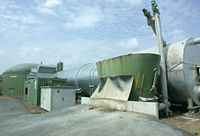
Photo from wikipedia
Abstract In order to deeply understand the inhibitory effect of ultrafine water mist containing methane-oxidizing bacteria on methane explosion, a small-sized semi-closed visual experimental platform was built. Five different application… Click to show full abstract
Abstract In order to deeply understand the inhibitory effect of ultrafine water mist containing methane-oxidizing bacteria on methane explosion, a small-sized semi-closed visual experimental platform was built. Five different application mist amounts (0.7 mL, 2.1 mL, 3.5 mL, 4.9 mL, 6.3 mL) of ultrafine water mist containing methane-oxidizing bacteria on 9.5% methane explosion were studied experimentally. Ultrafine water mist was generated by the ultrasonic atomization generator, and mist size was measured by a winner319 laser particle size analyzer. During the methane explosion, a high-frequency pressure sensor collected pressure change data, and a high-speed camera recorded the flame development process. The results indicated that the maximum explosion overpressure (ΔPmax) decreased with time, and the arrival time of the maximum explosion overpressure (ΔPmax) delayed. The appearance time of the “tulip” shaped flame delayed, and the flame propagation speed decreased. The ultrafine water mist and deposition can effectively inhibit the methane explosion. The explosion suppression effect of the second step spraying water mist was better. The improvement of the explosion suppression effect of the ultrafine water mist containing methane-oxidizing bacteria was attributed to the degradation effect of the methane-oxidizing bacteria. Under long-term degradation, methane-oxidizing bacteria in water mist play a role in inhibiting methane explosion.
Journal Title: Journal of Loss Prevention in The Process Industries
Year Published: 2020
Link to full text (if available)
Share on Social Media: Sign Up to like & get
recommendations!